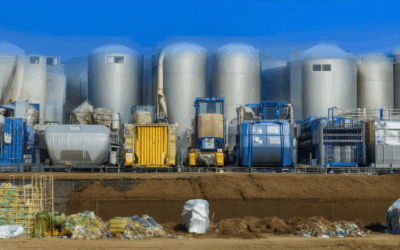Sustainable climate technologies are revolutionizing the way we address environmental challenges, offering innovative solutions to combat climate change. From renewable energy systems to smart infrastructure, these technologies are not only transforming industries but also paving the way for a greener future. In this comprehensive exploration, we delve into the latest developments, real-world applications, and future trends shaping the landscape of sustainable climate technologies. By examining cutting-edge innovations and their impact across various sectors, this article provides a deeper understanding of how these technologies are driving progress toward global sustainability goals. Whether you’re looking to learn about emerging trends or discover practical examples, this guide offers valuable insights into the role of sustainable climate technologies in shaping our world.
Key Takeaways
- Adopt renewable energy technologies like solar panels and wind turbines to reduce reliance on fossil fuels and lower carbon emissions.
- Implement carbon capture and storage (CCS) to remove CO2 from the atmosphere and mitigate climate change impacts.
- Leverage sustainable agriculture practices, such as regenerative farming, to enhance soil health and reduce agricultural emissions.
- Develop green infrastructure, including green roofs and permeable pavements, to mitigate urban heat islands and manage stormwater effectively.
- Deploy smart grids and energy management systems to optimize energy distribution and reduce waste.
- Shift to electric vehicles (EVs) to decrease transportation emissions and promote a low-carbon future.
- Embrace circular economy principles to minimize waste and maximize resource reuse, fostering sustainable living practices.
- Invest in climate-smart agriculture (CSA) to improve productivity, reduce emissions, and enhance resilience to climate-related disruptions.
- Harness renewable energy sources and implement energy efficiency measures to drive sustainable development and economic growth.
- Promote tree planting campaigns and large-scale reforestation efforts for effective carbon sequestration and biodiversity support.
- Support sustainable farming techniques and green transportation initiatives to create a more sustainable and resilient society.
- Utilize waste-to-energy plants and advanced recycling technologies to reduce landfill use and methane emissions.
- Explore desalination and water recycling technologies to address water scarcity and optimize resource use.
- Transition to electric vehicles and smart traffic systems to reduce pollution and improve urban mobility.
- Integrate climate-smart technologies across sectors to achieve sustainability, resilience, and foster economic growth.

Examples of Sustainable Technologies
Here are some notable examples of sustainable technologies that contribute to environmental preservation and resource efficiency:
- Solar Panels and Wind Turbines
- These renewable energy technologies convert sunlight and wind into electricity, reducing reliance on fossil fuels and lowering carbon emissions.
-
Electric Vehicles (EVs)
- EVs run on electricity, producing zero emissions, making them a sustainable alternative to traditional gasoline-powered cars.
-
Precision Farming
- Techniques like drones and IoT-enabled sensors optimize crop yields and reduce agricultural inputs, promoting sustainable agriculture.
-
Rainwater Harvesting Systems
- These systems collect and store rainwater for use in homes and gardens, reducing the demand on freshwater supplies.
-
Smart Irrigation Systems
- Utilizes sensors and data analytics to deliver water precisely where and when it’s needed, minimizing waste and conserving water.
-
Cross-Laminated Timber (CLT)
- A sustainable building material that reduces the carbon footprint of construction while maintaining strength and durability.
-
Green Roofs
- Roof systems that incorporate vegetation, absorbing heat and rainwater, helping to cool buildings and manage stormwater.
-
Biofuel Production
- Converts organic waste into biogas, providing a renewable energy source while managing waste effectively.
-
Composting Toilets
- Sustainable sanitation systems that convert human waste into nutrient-rich fertilizer, reducing the need for chemical fertilizers.
-
Recycling Technologies
- Advanced systems that sort and process waste into reusable materials, promoting a circular economy.
-
Permeable Pavement
- Materials that allow water to pass through, reducing runoff and recharging groundwater supplies.
-
Biodegradable Plastics
- Plastics made from renewable resources that decompose naturally, reducing plastic pollution.
-
Mushroom Packaging
- Eco-friendly packaging materials made from mycelium, a sustainable alternative to traditional plastics.
These technologies demonstrate innovative ways to address environmental challenges while fostering sustainable development. Explore more about these solutions and others on our blog and learn how we can work together to create a more sustainable future.
What Are Climate Technologies?
Climate technologies encompass a broad range of innovations designed to mitigate the effects of climate change and promote sustainable practices. These technologies aim to reduce greenhouse gas emissions, enhance carbon sequestration, and adapt to the impacts of climate change.
Key categories of climate technologies include:
- Renewable Energy Technologies: Solar panels, wind turbines, hydroelectric power, and geothermal energy systems that provide clean and sustainable energy alternatives to fossil fuels.
- Carbon Capture and Storage (CCS): Technologies that remove carbon dioxide from the atmosphere and store it underground, preventing its accumulation in the atmosphere.
- Smart Grids and Energy Storage: Advanced grid systems that integrate renewable energy sources and efficient storage solutions to manage energy supply and demand.
- Green Building Technologies: Designs and materials that reduce energy consumption, improve insulation, and incorporate renewable energy sources in buildings.
- Adaptation Technologies: Solutions that help communities and ecosystems adapt to the impacts of climate change, such as flood prevention systems, coastal protection, and drought-resistant irrigation techniques.
- Behavioral Change Technologies: Tools and platforms that encourage individual and collective actions to reduce carbon footprints, such as carbon footprint calculators, behavior-change apps, and gamification-based sustainability programs.
These technologies play a vital role in achieving global climate goals and ensuring a sustainable future. By adopting and promoting climate technologies, we can significantly reduce our environmental impact and build resilience against climate-related challenges.

Examples of Climate Tech
Here are some notable examples of climate technology innovations:
- Pyrolysium : Specializes in sustainable living solutions through innovative technologies like pyrolysis, transforming organic waste into valuable resources such as biochar. Their mission focuses on reducing environmental impact and promoting eco-friendly practices. Learn more
- Tesla : Known for pioneering electric vehicles and solar energy systems that significantly reduce carbon emissions. Their products contribute to a cleaner energy future. Visit Tesla
- NextEra Energy : A global leader in renewable energy, including wind farms and solar power plants. They play a major role in transitioning to a low-carbon economy. Explore NextEra Energy
- Climeworks : Pioneers in carbon capture technology, developing solutions to remove CO2 from the atmosphere and prevent climate change. Discover Climeworks
These innovations highlight the diverse approaches being taken to address climate challenges and promote sustainable development.

What Are Climate Technology Solutions?
Climate technology solutions encompass a broad array of innovations designed to mitigate the effects of climate change and promote sustainable practices. These technologies aim to reduce greenhouse gas emissions, enhance resource efficiency, and adapt to the impacts of climate change.
- Renewable Energy Technologies: Solutions like solar panels, wind turbines, and geothermal systems that provide clean energy alternatives to fossil fuels.
- Carbon Capture and Storage (CCS): Technologies that remove carbon dioxide from the atmosphere and store it underground to prevent its accumulation in the atmosphere.
- Sustainable Agriculture and Food Systems: Practices such as regenerative farming, agroforestry, and crop rotation that enhance soil health and reduce agricultural emissions.
- Green Infrastructure: Development of urban green spaces, green roofs, and permeable pavements that mitigate urban heat islands and manage stormwater effectively.
- Smart Grids and Energy Management: Advanced grid systems that integrate renewable energy sources and optimize energy distribution to reduce waste and increase efficiency.
- Electric Vehicles (EVs): Transportation solutions powered by electricity, reducing reliance on fossil-fuel-powered vehicles and lowering emissions.
- Circular Economy Practices: Systems that minimize waste and maximize resource reuse, such as recycling programs and product lifecycle assessments.
These solutions work together to create a more sustainable and resilient world, addressing both the causes and consequences of climate change. By adopting and advancing these technologies, we can pave the way for a cleaner, greener future.
For more information on how Pyrolysium supports these initiatives, visit our website and explore our resources on sustainable living and eco-friendly technologies.
What Are 5 Examples of Climate Change Solutions?
Addressing climate change requires innovative and actionable solutions. Here are five effective approaches:
-
Solar Energy Adoption
Switching to renewable energy sources like solar panels significantly reduces greenhouse gas emissions. Installing solar panels on homes and businesses can drastically lower energy costs and carbon footprints. Learn more about solar energy solutions .
-
Wind Farm Development
Wind farms harness clean energy to power millions of households. Expanding wind energy capacity helps reduce reliance on fossil fuels and combat climate change effectively. Explore wind energy projects .
-
Tree Plantation Campaigns
Planting trees absorbs CO2 and supports biodiversity. Large-scale tree planting initiatives, such as reforestation efforts, play a crucial role in carbon sequestration. Discover forest conservation programs .
-
Sustainable Agriculture Practices
Farmers adopting organic farming methods and reducing chemical use can significantly lower agricultural emissions. This approach enhances soil health and reduces environmental impact. Find sustainable farming techniques .
-
Green Transportation Initiatives
Shifting to electric vehicles (EVs) and expanding public transit systems reduces pollution from transportation. Governments and organizations investing in EV infrastructure are making a positive impact. Investigate green transportation options .

What Are Climate-Smart Technologies?
Climate-smart technologies encompass a range of innovative solutions designed to address the challenges posed by climate change while promoting sustainable development. These technologies aim to enhance efficiency, reduce environmental impact, and support adaptive strategies to cope with changing climatic conditions.
Key Categories of Climate-Smart Technologies
- Agriculture
- Climate-Smart Agriculture (CSA) : Integrates traditional farming practices with modern technologies to improve productivity, reduce greenhouse gas emissions, and enhance resilience to climate-related disruptions. Techniques include crop rotation, soil conservation, and precision agriculture tools powered by AI and IoT.
- Energy
- Renewable Energy : Technologies like solar panels, wind turbines, and geothermal energy systems reduce reliance on fossil fuels and lower carbon emissions.
- Energy Efficiency : Smart grids and energy storage solutions optimize energy distribution and consumption, minimizing waste and improving reliability.
- Urban Planning and Infrastructure
- Green Roofs and Permeable Pavements : These technologies help manage stormwater runoff and reduce urban heat island effects, contributing to cooler cities and better air quality.
- Carbon Capture : Technologies like biosequestration and carbon dioxide removal systems trap CO2 from the atmosphere, helping to mitigate atmospheric warming.
- Waste Management
- Waste-to-Energy Plants : Convert municipal waste into energy through advanced incineration and gasification processes, reducing landfill use and methane emissions.
- Recycling and Composting Technologies : Innovations in sorting and processing systems maximize material recovery rates, decreasing the environmental footprint of waste disposal.
- Water Management
- Desalination and Water Recycling : Technologies that turn seawater or brackish water into fresh water, addressing water scarcity issues.
- Irrigation Efficiency : Smart irrigation systems using sensors and data analytics reduce water usage while optimizing crop yields.
- Transportation
- Electric Vehicles (EVs) : Transitioning to EVs reduces greenhouse gas emissions associated with traditional internal combustion engines.
- Smart Traffic Systems : Real-time monitoring and dynamic routing software improves traffic flow, reducing fuel consumption and emissions.
Benefits of Climate-Smart Technologies
- Sustainability : Reduces reliance on non-renewable resources and minimizes environmental degradation.
- Resilience : Enhances the ability of ecosystems and human societies to adapt to climate change impacts.
- Economic Growth : Supports innovation and job creation in emerging technology sectors.
By adopting these technologies, we can create a more sustainable and resilient future while contributing to global efforts to combat climate change.




0 Comments